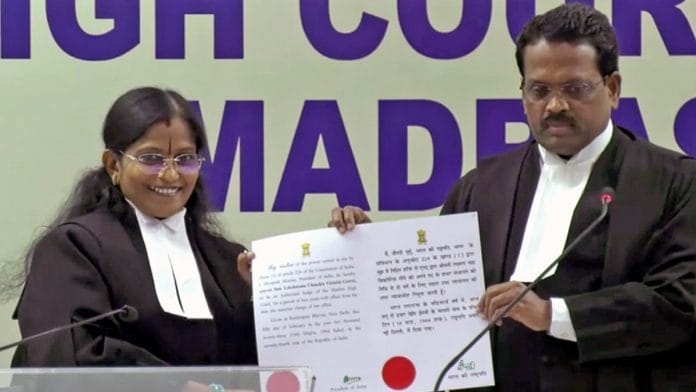New Delhi: Last week, the Supreme Court witnessed unprecedented controversy over the appointment of L. Victoria Gowri as an additional judge of the Madras High Court.
The Supreme Court collegium had recommended Gowri’s elevation to the high court on 17 January. However, her appointment has been controversial since, with lawyers from the Madras High Court writing to Chief Justice of India D.Y. Chandrachud, seeking recall of the recommendation, alleging that she made ‘hate speeches’ against Christians and Muslims. Two petitions were then filed in the Supreme Court, including one by senior advocate R. Vaigai, challenging the recommendation for her elevation.
Her appointment was notified on Monday. The Supreme Court had then, on Tuesday, refused to interfere with Gowri’s appointment, saying that the political affiliation of a candidate or public expression of their views does not impact their work as a judge. While Gowri took oath as an additional judge of the Madras High Court on Tuesday, detailed reasons for the court’s rejection of the petitions were made public Friday.
However, this isn’t the first time that a judge’s appointment has been challenged in the Supreme Court. In fact, back in 1992, the apex court had quashed the appointment of one K.N. Srivastava as a judge of the Gauhati High Court, before he could take oath as a judge. The petitioners in Gowri’s case had also cited this 1992 case to challenge her appointment.
ThePrint explains why the Supreme Court set aside the judge’s appointment in 1992, but not that of Victoria Gowri.
Also read: Hindenburg report: ‘How to ensure investors are protected,’ SC seeks suggestions from SEBI
The 1992 case
The 1992 case pertained to the controversy around the appointment of K.N. Srivastava as a judge of the Gauhati High Court.
The President had notified Srivastava’s appointment on 15 October 1991. However, he had not taken oath as a judge yet. The question before the court was whether his appointment would violate Article 217 of the Constitution, which talks about appointment of judges to the high courts, and lists down the eligibility criteria for their appointment. Among other things, this provision says that a person would be qualified to be appointed as a high court judge only if he has held a ‘judicial office’ in India for at least ten years or has practised as a high court lawyer for at least ten years. A lawyer had challenged Srivastava’s appointment in the Gauhati High Court, and this petition was then transferred to the Supreme Court.
Before the Supreme Court, it was argued that Srivastava had neither practised as an advocate for ten years, nor held any judicial office. At the time of his recommendation, he was working as the legal remembrancer and secretary with the law and judicial department of the Mizoram government.
While there were corruption allegations against Srivastava as well, the Supreme Court restricted its judgment to the issue of his eligibility for appointment to the high court. It then declared that Srivastava was, in fact, not qualified to be appointed as a high court judge, and quashed his appointment.
‘First time in independent India’
The 1992 judgment had taken note of the atypical nature of allegations before it. It had noted that “it was for the first time in the post-independent era that this court is seized of a situation where it has to perform the painful duty of determining the eligibility of a person who has been appointed a judge of high court by the President of India and who is awaiting to enter upon his office.”
The petitioners in Gowri’s case relied on this judgment to show that the Supreme Court can set aside the appointment of a judge, even when an appointment order has been issued.
However, Srivastava’s case was decided before the collegium system was crystallised by the second judges’ case in 1993 and the third judges’ case in 1998. Therefore, if the Supreme Court had interfered in Gowri’s appointment, this would have been the first such intervention against a recommendation made by the Supreme Court collegium.
‘Related to eligibility’
However, the case related to Gowri did not challenge her “eligibility” to be appointed as a judge in the high court. The Supreme Court’s judgment on Gowri, by a bench comprising Justices Sanjiv Khanna and B.R. Gavai, referred to past judgments which differentiate between the eligibility of a candidate for evaluation, from the evaluation of the worth and merit of a candidate.
Citing these judgments, it pointed out that while it can look into the eligibility of a candidate, the question whether a person is fit to be appointed as a judge involves the aspect of suitability and stands excluded from the purview of judicial review. In Gowri’s case, the concerns raised pertained to her suitability and not her eligibility.
The Supreme Court then pointed out that the 1992 judgment was passed in “a case relating to eligibility of a person, in whose favour the warrant for appointment as a judge of the high court had been issued, but who was not qualified to be appointed as a judge of the high court”.
“The ratio of this judgment cannot be extended to apply the power of judicial review to examine the suitability or merit of a candidate,” it added, rejecting the petitions against Gowri’s appointment.
(Edited by Smriti Sinha)
Also read: ‘Man freed in Chhawla rape-murder case now held for murder’ — Delhi Police to SC in review plea






